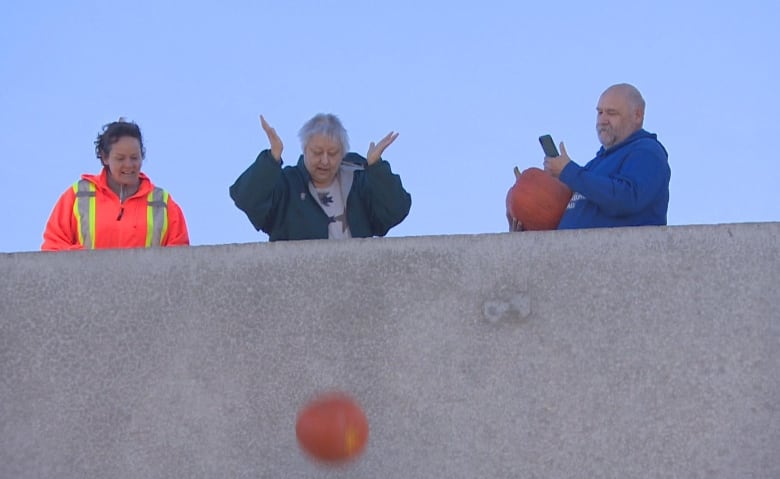
Shrieks and giggles filled the air on Saturday as Winnipeggers lined up to pitch withered Halloween pumpkins off the CF Polo Park parkade, blowing off steam while keeping tonnes of the big orange vegetables from going to waste.
“It’s another fun activity for the children with the pumpkins, after all the candies are gone and the sugar rushes are over,” said Jill Parsonage, who came with several smiling kids in tow.
“And it’s a great way to avoid having more waste go into the landfill.”
Hosted by Compost Winnipeg, the second annual Pumpkin Drop also raised money for year-round composting programs around the city.

Sylvia Girouard brought her youngest grandson, Matthew, who shoved their slightly shrivelled jack-o’-lantern off the edge of the two-storey parking structure. It splattered pumpkin mush and stringy seeds into a one-tonne truck parked below.
“It was really fun,” said Matthew, 8, his eyes lighting up with a shy, gleeful grin. “It felt really satisfying when it fell.”
“Yeah, you broke my pumpkin!” Girouard chuckled loudly.
She was especially pleased a big pile of the pumpkins will help feed animals at Little Red Barn Sanctuary in Oakville, Man.
“Pumpkins are very nutritional, I’m really glad they’re doing that,” said Girouard.

Eight-year-old volunteer Christian Dela Cruz helped sort the colourful fall squashes into edible and non-edible piles.
“All the ones that are not damaged, we’re putting them into this truck,” said the boy, who tossed miniature, decorative pumpkins into a pickup parked on the roof.
“It’s nice to give the farm animals different food to eat,” he added.
Bringing attention to ‘hierarchy of food waste’
Fresh pumpkins that were never painted or pierced were set aside for organizations, including Community Helpers Unite Inc. and the Leftovers Foundation, to be made into puree and cooked into meals.
Those already carved into jack-o’-lanterns were checked for candles and other debris, then tossed into the bin, about 10 metres below.
“There’s so many things that we’re doing with this event,” said Karrie Blackburn from Compost Winnipeg, a social enterprise run by the Green Action Centre.

“Firstly, keeping pumpkins out of the landfill. Secondly, we’re bringing attention to the hierarchy of food waste,” she said, adding the group doesn’t want organic items immediately sent to the compost pile either.
“There’s opportunities to feed people by upcycling these pumpkins into food,” said Blackburn.
The group is also taking cash donations to fund a compost service for a local non-profit, yet to be determined. Money raised at last year’s Pumpkin Drop helped launch a compost program at Bruce Oake Recovery Centre.
“They started composting with us in July,” said Blackburn, “and they’ve already diverted over 3,000 kilograms of waste, and are up to four bins on a weekly collection schedule.”
She said the 2021 event amassed roughly 24,000 kilograms of pumpkins, which Compost Winnipeg estimates to be about 10 per cent of all the Halloween pumpkins bought in Manitoba last year.

Blackburn said that’s a substantial achievement, since pumpkins that end up in landfills don’t properly decompose, with results that may come back to haunt us.
“Without oxygen present, you don’t have all those good microbes,” she said. “This means the pumpkin will go septic. It produces a very powerful greenhouse gas, methane, which as we all know is a big contributing factor to climate change.”
Turning the bulbous vegetables into compost instead offers additional benefits, said Blackburn.
“That compost can go to be a soil amendment, or can actually be used in landfill remediation,” she explained, saying city dumps deal with waste by alternating layers of garbage and dirt, almost like a giant lasagna.
Blackrun said compost is a better alternative to what’s often used in that process now.
“Not only does it prevent us from having to use topsoil, which is not a renewable resource, it also sequesters emissions that do come out of our landfills.”
City composting pilot ended in September
Compost Winnipeg recently got funding from the city to help expand its residential and commercial collection services.
The City of Winnipeg wrapped up its residential food waste collection pilot program in September, with a report to be delivered to city council next year.
Blackburn hopes councillors act swiftly toward a citywide compost collection program.
“We’re about a decade behind most major cities when it comes to organic waste diversion,” she said, adding that pickup service for single-family homes is at least several years away.
In the meantime, Winnipeggers can sign up for Compost Winnipeg’s collection program for about $35 per month.
Blackburn said about 40 per cent of household waste is organic matter that could be composted, thereby nearly doubling the life of landfills while reducing methane emissions.
“It’s a very small step that you can make in your day-to-day life to have a direct impact on preserving the longevity of our planet,” she said.












